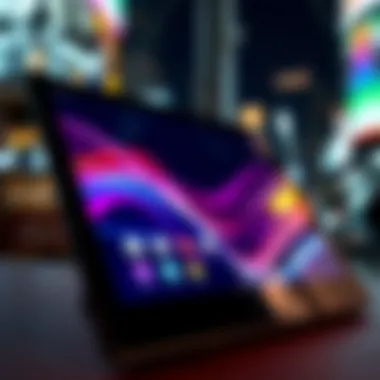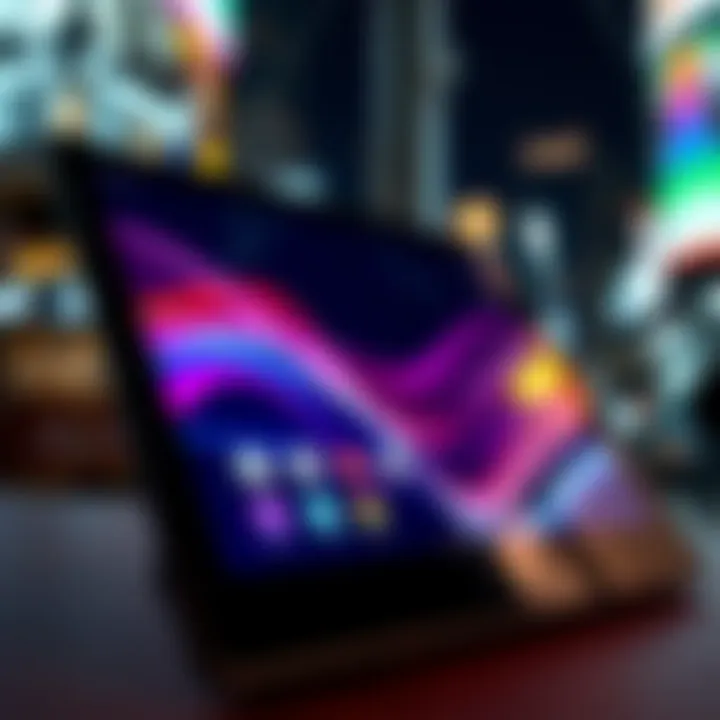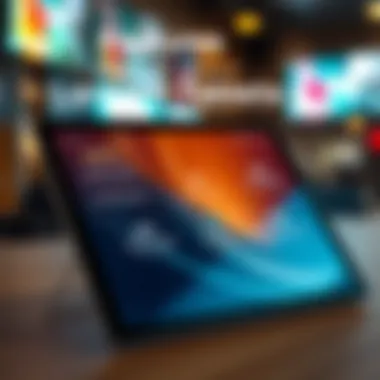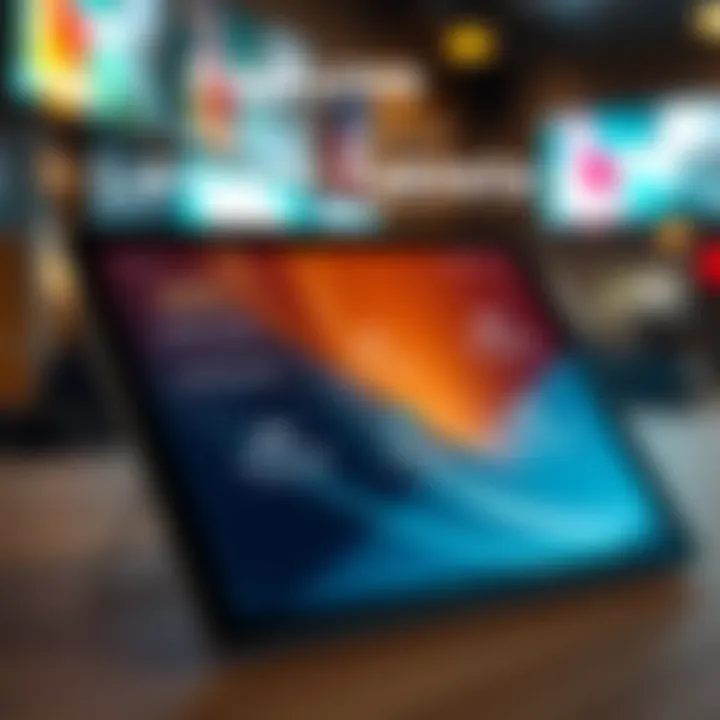Exploring the Potential of Large WiFi Tablets


Overview
Preface to the topic of the article
Large WiFi tablets have garnered considerable attention in recent years, transcending mere digital convenience to become essential tools in various aspects of modern life. These versatile devices blend portability with a larger display, catering to diverse users from remote workers to avid media consumers. But what exactly sets these tablets apart? Understanding their potential means diving into a world that fuses design, functionality, and user experience.
Brief background information
The evolution of tablets began with smaller, more simplistic devices, mainly designed for brief browsing and light tasks. However, as technology advanced, the shift towards larger screens began. Large WiFi tablets now feature enhanced specifications that allow for multilayered usage, appealing to both casual and professional demographics. The demand for such tablets has surged, driven by increased reliance on digital solutions in everyday tasks.
Features & Specifications
When considering large WiFi tablets, one can't overlook their impressive range of features. Below is a breakdown of some key technical specifications:
- Display Size: Usually ranging from 10 to 15 inches, allowing for a more engaging viewing experience.
- Processor Quality: High-performance processors, comparable to those found in laptops, capable of handling demanding tasks.
- RAM: Often equipped with 4 GB to 16 GB, providing smooth multitasking capabilities.
- Storage Options: Usually offering a range from 64 GB to 512 GB; many allow external storage via microSD cards.
- Battery Life: Typically lasting between 8 to 12 hours on a single charge, making them suitable for extended use away from power sources.
- Connectivity: Usually featuring WiFi 5 or WiFi 6 for faster internet access, and often Bluetooth capability for peripheral devices.
- Operating System: Common systems like Android or iOS, providing a wide selection of applications.
These specifications not only enhance the user experience but establish large WiFi tablets as powerful mobile computing solutions.
Pros and Cons
Like any piece of technology, large WiFi tablets come with their share of advantages and disadvantages:
Advantages:
- Enhanced Portability: They strike a balance between size and functionality, making them easy to carry.
- Multifunctionality: Capable of serving various purposes—work, entertainment, education—all within one device.
- Larger Display: An added size allows for more immersive experiences whether it’s streaming movies, playing games, or reading documents.
Disadvantages:
- Price Point: They can be on the pricier side compared to smaller tablets or basic laptops.
- Weight: Some users find them heavier than traditional tablets, which can be cumbersome for long periods.
- Less, but Still Adequate App Ecosystem: Not all applications optimized for larger screens, which may hinder user experience.
User Experience
Exploring the real-world impact of large WiFi tablets reveals varied user impressions. Many users praise the immersive experience they offer, especially for video streaming and gaming. One customer shared, "The screen is a game changer! Watching movies feels like I'm in a theater. Everything is crisp and clear."
However, others have pointed to the weight as a potential drawback, noting that prolonged use can lead to discomfort. An individual remarked, "It's powerful, sure, but lugging it around for hours? Not so much fun."
These insights indicate that while these tablets serve multiple needs effectively, they are not without their challenges.
Buying Guide
For those pondering over the purchase of a large WiFi tablet, a few considerations can be crucial:
- Purpose: Identify your primary use case—be it professional, educational, or for entertainment.
- Budget: Determine how much you are willing to spend. High-end models offer more features.
- Brand Reputation: Some brands like Apple, Samsung, and Microsoft provide established reliability and customer support.
- Specifications: Opt for models with adequate processor and RAM according to your anticipated usage level.
- User Reviews: Don't forget to go through user experiences to gauge real-world functionality.
Investing in the right large WiFi tablet can enhance your digital toolkit significantly, keeping productivity and leisure within arm’s reach.
If you're still on the fence, consider looking at resources like Wikipedia, or user forums on websites such as Reddit.
Prelims to Large WiFi Tablets
In today’s rapidly evolving tech landscape, large WiFi tablets have emerged as pivotal devices that bridge the gap between smartphones and laptops. Their growing importance is evident in various sectors, from education to entertainment, as they facilitate seamless access to information and applications. For consumers navigating the digital world, understanding large WiFi tablets is essential to making informed decisions.
These gadgets offer several unique benefits, particularly in their usability features. With larger screens, they enhance visibility and make multitasking a breeze. Users find that simply scrolling through documents, watching videos, or participating in video calls is far more enjoyable on larger displays.
The flexibility of large WiFi tablets also cannot be overstated. They function admirably for casual browsing as well as professional tasks requiring extensive data handling. Features like high-resolution displays and robust processing power make them appealing options for both casual users and heavy-duty professionals.
Defining Large WiFi Tablets
Large WiFi tablets are typically defined by their screen size, measuring usually 10 inches or more diagonally, alongside their built-in WiFi capabilities, enabling internet connectivity without the need for cellular data. They blend the portability of a tablet with the functionality typically expected from a laptop.
Sizes can vary quite a lot, from the comfortably manageable 10-inch variety to larger, almost laptop-like 15-inch models. Most large WiFi tablets also come equipped with advanced features and capabilities, including touch-sensitive screens, app ecosystems, and compatibility with external peripherals like keyboards and styluses.
"Large WiFi tablets allow users to engage deeply with content, harnessing the capabilities of touch interfaces and high-quality displays."
These devices cater to a range of user needs, whether for personal leisure, educational purposes, or professional tasks. As a result, they support a vast array of applications, enhancing both productivity and creativity.
Historical Context and Evolution
The journey of large WiFi tablets began when the traditional tablet market took off in the early 2010s. Initially, tablets were smaller and struggled to differentiate themselves from smartphones. However, as technology advanced, manufacturers began to recognize the potential of larger screens.
The release of devices with greater screen sizes around 2013 marked a turning point. As responsive touch technology improved, so did the functionalities of these devices. Companies like Samsung and Apple offered larger tablets targeting not only casual users but also students and professionals looking for more robust solutions. Functionality expanded to include everything from educational tools to complex productivity applications, making large WiFi tablets more appealing to broad audiences.
More recently, the advent of cloud computing and enhanced internet speeds has also fueled the growth of these devices. Users can now run applications directly from the cloud, necessitating more powerful processors and larger screens to effectively manage complex tasks—something only large WiFi tablets can offer efficiently.


Design Elements of Large WiFi Tablets
The design elements of large WiFi tablets play a significant role in shaping user experience and functionality. In a world where digital interaction has become second nature, the aesthetics and practicality of these devices are critical for satisfaction and performance. Key design elements include screen size and resolution, build quality and materials, and weight and portability. Each of these factors influences not only the usability of the tablet but also how well it fits into the daily lives of consumers.
Screen Size and Resolution
The size of a tablet screen is more than just a matter of visibility; it directly impacts how engaging and functional the device can be. A larger screen allows for a more immersive experience, whether you're watching movies, playing games, or multitasking with several applications open simultaneously. Tablets with screens ranging from 10 to 14 inches are often preferred, as they strike a balance between usability and portability.
Resolution also plays a critical role in this aspect. Higher pixel densities result in sharper images and text, allowing for reading or viewing without strain. For instance, tablets like the Apple iPad Pro come with Liquid Retina display technology that offers vibrant colors and deep contrasts, enhancing the overall usability of the device. On the other hand, lower resolution screens can lead to grainy visuals, making detailed tasks cumbersome.
In this context, consumers increasingly seek devices that offer not only a larger physical display but also superior pixel clarity.
Build Quality and Materials
When it comes to design, the materials used in construction can’t be overlooked. A tablet's build quality signifies its durability and longevity. High-quality materials not only enhance aesthetic appeal but also help in withstanding the daily wear-and-tear. For example, many premium tablets use aluminum bodies, which provide both a sleek appearance and robustness.
Additionally, the type of glass utilized is also crucial. Tablets with Gorilla Glass, for example, resist scratches and cracks better than their counterparts. This durability is especially important for users who carry their devices everywhere.
Moreover, the design should also take ergonomics into account. Tablets that are too slick or heavy can become uncomfortable to hold for long periods, leading to what some call 'tablet fatigue'. Therefore, manufacturers are working on creating designs that ensure ease of use and comfort.
Weight and Portability
Weight is another vital aspect, playing a key role in the overall user experience. A lightweight tablet enhances portability, allowing users to easily carry their device wherever they go, whether it's for work or leisure. Most consumers prefer a tablet that is easy to slip into a bag without adding unnecessary bulk.
An ideal tablet should ideally weigh under 1.5 pounds, so users can handle it with one hand without feeling like they're holding a brick. For instance, devices like the Samsung Galaxy Tab S series are often lauded for their light designs. Although users often prioritize screen size and powerful features, portability shouldn’t be off the table. It connects directly to how actively a person will engage with their device throughout the day.
Core Features of Large WiFi Tablets
The core features of large WiFi tablets serve as the backbone of their appeal and functionality. Understanding these elements invites users to appreciate not just how the devices work but why they stand out in a crowded field of tech gadgets. This part zeroes in on key attributes that define user experience and performance, which can be a critical factor for anyone considering entry into the tablet market. In a world where efficiency and usability reign supreme, these core attributes help elucidate the practical benefits that large WiFi tablets offer.
Processing Power and Performance
The processing power of a large WiFi tablet directly influences its ability to handle various tasks with ease. Unlike smaller tablets or smartphones, larger models often come equipped with more robust processors, allowing for a smooth user experience, especially during demanding activities like gaming or video editing. They’re not just about size; it's about muscle. Higher performance translates to faster app load times and better multitasking capabilities, which can be a game changer for professionals and students alike.
For instance, tablets running on Apple’s M1 chip or Qualcomm's Snapdragon series demonstrate that powerful hardware doesn’t have to come from traditional laptops. The capability to run desktop-class applications gives users the flexibility to accomplish more on-the-go, ensuring that productivity never takes a backseat.
Battery Life Considerations
When it comes to large WiFi tablets, battery life is always a hot topic. A device can have all the bells and whistles, but if you’re charging it every few hours, prospects of uninterrupted use goes out the window. Most high-end models now boast batteries that last a full day or more, even with heavy use.
Let's not forget the advancements in charging technology as well. Quick-charge features are not just a luxury, but a necessity in our fast-paced lives. Users are right to expect their tablets to keep up with their routine. Whether it's attending virtual classes or binge-watching shows, a reliable battery life makes all the difference in user satisfaction.
Connectivity Options
Connectivity features are vital for maximizing the functionality of large WiFi tablets. Users don’t just want to browse the web or stream content; they expect versatility and seamless integration with multiple devices.
WiFi Standards and Capabilities
WiFi standards have come a long way, further boosting the capabilities of large WiFi tablets. Most contemporary models support WiFi 6, which offers faster speeds and improved performance in crowded settings where many devices are vying for bandwidth. This is particularly important in homes or offices where multiple users and devices are connected simultaneously. Users can stream high-definition content without buffering issues, making for an overall smoother experience.
Moreover, WiFi 6 introduces features like OFDMA, which makes it efficient for data management for heavy users. This means less time waiting for content to load. It's a beneficial choice for anyone who values efficiency and speed in their digital life.
Bluetooth Integration
Bluetooth integration extends the functionality of large WiFi tablets. This feature allows users to connect to a plethora of devices, from headphones and speakers to keyboards and mice without a hassle. With the rise of wireless peripherals, tablets that support the latest Bluetooth technology can provide a more cohesive and flexible productivity environment.
What’s nice about Bluetooth is its ease of use—once devices are paired, they can connect automatically without further setup. This minimizes disruptions and maintains a fluid workflow.
Other Connectivity Features
Beyond WiFi and Bluetooth, large WiFi tablets often come equipped with a range of other connectivity features, enhancing their versatility. Many models include USB-C ports, which allow for fast data transfer and charging, often supporting video output as well. Adaptive Connectivity has become a key selling point for consumers who wish to connect their tablets to larger displays for presentations or entertainment.
Users should also pay attention to options like cellular connectivity, which can be a boon for those frequently away from WiFi hotspots. This ensures that a tablet can maintain internet access without tying users down to a single location. Amid advancements in connectivity, choices well-suited for diverse user needs are increasingly available, enhancing the overall appeal of large WiFi tablets.
"The core features of large WiFi tablets act like the engines of a vehicle; without a powerful and efficient engine, even the best vehicle can hardly impress on the road of daily activities."
User Experience and Interface
When it comes to large WiFi tablets, the user experience and interface play a crucial role. They dictate not only how individuals interact with these devices but how effective and enjoyable that interaction can be. A well-designed user experience can make even complex operations feel intuitive and seamless. Conversely, a confusing interface can lead to frustration and underutilization of the device's features.
Operating Systems and Compatibility
One of the first considerations in user experience is the operating system (OS). Commonly found operating systems in large tablets include Android, iOS, and Windows, each bringing its own flavor and compatibility spectrum. For instance, Android tablets usually provide a highly flexible experience, allowing users to customize their home screens, while iOS devices often offer a smoother, albeit more restrictive, ecosystem. Windows tablets might appeal to those looking for a traditional desktop experience, as they often mimic the functionalities of a PC, making them particularly suited for business and professional tasks.


Moreover, compatibility with various software applications adds another layer of convenience. Users should consider whether their essential apps run on their tablet's operating system. This compatibility can greatly enhance productivity, especially for professionals relying on platforms like Microsoft Office or design software.
User Interface Design Principles
The principles of user interface (UI) design come into play to enhance usability. Effective UI design includes a clean layout, intuitive navigation, and accessible features. For example, when a tablet allows quick access to commonly used apps through succinct menus or gestures, the experience becomes more fluid. There’s also the matter of visual hierarchy; users should easily discern primary actions from secondary options, which streamlines their workflow.
Additionally, responsiveness is key. A lagging interface can ruin the experience, producing a disconnect between the user's intent and the tablet’s action. High-resolution displays and snappy transitions not only look good but also indicate a device's performance capabilities. Hence, tablets with responsive touchscreens and well-organized interfaces tend to be preferred.
App Ecosystem and Functionality
Lastly, the strength of the app ecosystem is an important factor. A diverse and rich app selection can significantly enhance the utility of large WiFi tablets. Users often seek applications that cater to a range of activities, from entertainment to productivity.
For instance, educational apps can provide interactive learning experiences, whereas specialized software can assist graphic designers or marketers. The ecosystem’s integration with cloud services can also boost efficiency, allowing access to files anywhere. Furthermore, larger tablets are often better suited for multitasking, enabling smoother transitions between apps—something that appeals to tech enthusiasts who juggle multiple tasks at once.
Thus, when assessing large WiFi tablets, one cannot overlook user experience and interface. They are not mere components; they are the lifeblood of how effectively these devices serve their users. A well-rounded understanding of these aspects can guide users in selecting the tablet that best fits their lifestyle and needs.
Applications of Large WiFi Tablets
The role of large WiFi tablets has extended far beyond their initial conception. This article delves into their various applications, showcasing how they are redefining user experiences across different spheres. From education to professional environments, and even in leisure activities, these devices are wearing multiple hats. The versatility of large WiFi tablets is something to marinate on.
Educational Uses
Digital Learning Platforms
Digital learning platforms are revolutionizing education through the utilization of large WiFi tablets. These online ecosystems, where students and educators converge, play a pivotal role in modern teaching and learning methodologies. What sets these platforms apart is their ability to deliver course material through interactive content. This interactivity typically includes videos, quizzes, and collaborative projects, all accessible with a few taps on a screen.
One of the key characteristics of digital learning platforms is their capacity for personalized learning experiences. They allow students to learn at their own pace, catering to individual needs—something traditional classrooms sometimes struggle to achieve. The advantage lies in the instant feedback provided to learners. However, it’s worth mentioning that too much reliance on technology can hinder the development of interpersonal skills, something essential in social settings.
Interactive Learning Experiences
Interactive learning experiences elevate the educational landscape by making knowledge acquisition both engaging and immersive. Utilizing tools such as augmented reality (AR) and virtual reality (VR), large WiFi tablets can transform standard lesson plans into adventures through time and space. This key characteristic drives the increased popularity of interactive experiences in education.
Students today want to interact and not simply absorb information passively. The visual and kinesthetic learning styles benefit greatly from this approach, as it enables a deeper connection to the material. One unique feature worth noting is the ability to incorporate gamification elements into lessons, which increases motivation among learners. However, these experiences can sometimes be cost-prohibitive for institutions lacking funds or resources, which limits their widespread adoption.
Professional and Business Applications
Remote Work Capabilities
The capabilities of large WiFi tablets for remote work cannot be underestimated. They provide flexibility, enabling professionals to perform tasks from almost anywhere with internet access. This characteristic is especially valuable in today’s dynamic job market, where the traditional office setup is shifting toward more fluid arrangements.
One of their unique features is the portability coupled with powerful performance. Users can seamlessly operate essential software, engage in video conferences, and share files on the fly. Large WiFi tablets also often feature long battery lives, allowing lengthy work sessions without frequent charging. Challenges do arise; however, as some tasks may be better suited for a traditional laptop setup regarding precision and multitasking capabilities.
Collaboration Tools and Software
Collaboration tools and software specifically designed for large WiFi tablets are making teamwork more efficient than ever. Tools such as shared document editors, project management applications, and communication platforms facilitate a collaborative environment that can transcend geographical borders. The ease of access through intuitive interfaces makes them a favored choice for many teams.
The unique advantage here lies in real-time collaboration. Team members can edit documents simultaneously, exchange ideas, and pivot strategies without missing a beat. Yet, it’s essential to remember that reliance on these tools may create challenges, such as security concerns regarding sensitive information shared over cloud platforms.
Entertainment and Media Consumption
Movies and Streaming Services
Large WiFi tablets serve as ideal portals for consuming media, specifically movies and streaming services. Their expansive displays create an immersive viewing experience that rivals even some standard televisions. This functional aspect, combined with the capability to download content for offline viewing, makes them particularly appealing for viewers on the go.
What makes these tablets a fantastic choice for entertainment is not just their screen size but also their compatibility with various streaming applications. Subscribing to popular platforms like Netflix, Hulu, or Disney+ provides an extensive library of engaging content, directly accessible from the palm of your hand. However, the downside can emerge in the form of battery drain during prolonged viewing sessions, which may necessitate planning for recharging breaks.
Gaming Experiences
Gaming on large WiFi tablets has evolved into a popular application that’s gathering traction rapidly. The devices provide a seamless gaming experience thanks to robust processing power and superior graphics. Users can engage with their favorite titles, whether they are heavy-hitters like Call of Duty Mobile or casual games like Candy Crush, all with an impressive level of detail.
One key characteristic notable in gaming experiences on these tablets is the touchscreen interface, which often enhances gameplay. It brings a unique tactile quality to interactions, making games feel more intuitive. However, the catch lies in the gaming sessions that can potentially be curtailed by the weight of the device over time or a lack of physical buttons that certain gamers prefer for competitive play.
In summary, the applications of large WiFi tablets touch every corner of daily life—education, work, and leisure. Their versatility and capabilities make them indispensable tools in the modern world, streamlining processes and enriching experiences in ways previously unimaginable.
Performance Comparisons with Other Devices
In our digital age, understanding the comparative performance of large WiFi tablets against other devices is pivotal for consumers making informed decisions. This section sheds light on the distinctive advantages and uses that these tablets offer when stacked against laptops and smartphones, allowing an insight into where each device shines and how they cater to different needs.
Tablets vs. Laptops
When we throw tablets into the mix with laptops, the conversation can get a bit heated. Laptops, with their traditional keyboard and multitasking capabilities, have long been the kings of productivity. However, large WiFi tablets are like the new kids on the block, bringing a fresh perspective to the table.
- Portability: Tablets tend to be lighter and more portable than the average laptop. This mobile prowess is especially valuable for users who are always on the go, whether they’re moving from meeting to meeting or grabbing a quick coffee. When it comes to convenience, you simply can’t beat slipping a tablet into your bag without breaking a sweat.
- User Interface: The touch screen on many large tablets creates a more tactile interaction, which some folks find more intuitive than a conventional touchpad or mouse. The swipe, pinch, and tap motions feel more natural, especially for activities like browsing, reading, or sketching.
- Battery Life: Generally speaking, large WiFi tablets offer impressive battery longevity. They tend to last longer on a single charge compared to most laptops. This can be a game-changer when out in the field or during long travel days where an outlet might not be handy.


"Tablets are paving a new way in personal computing, combining portability with ease of use that resonates with the modern user."
Still, laptops boast their own set of ironclad features:
- Diverse Software: Laptops typically support a broader suite of professional applications, which makes them a favorite for serious work tasks that require heavy lifting. Programs such as Adobe Premiere Pro or complex data analytics tools often run best on laptops.
- Power and Performance: With more powerful CPUs and GPUs, laptops can handle intensive tasks that just aren’t feasible on many tablets. This advantage is particularly noticeable in gaming and high-end graphic design work.
Tablets vs. Smartphones
Shifting the focus to the smartphone realm, the comparison with large WiFi tablets reveals another layer of complexity. Both devices aim to connect users to the digital world, yet their functionalities serve different purposes.
- Screen Real Estate: The larger screens of tablets offer a better viewing experience for multimedia consumption, whether it’s streaming movies or playing games. It’s like comparing a postage stamp to a canvas. Glaring small text and cramped interfaces on smartphones can be limiting, while tablets provide more breathing room for apps and content.
- Usability for Tasks: For prolonged tasks such as reading documents or browsing the web, tablets are far superior. They often come equipped with features that cater to productivity, like compatible keyboard attachments, which mesh well with a larger digital workspace.
- Communication Style: On the flip side, smartphones are incomparable for on-the-go communication. They fit snugly into your pocket and offer instant access to texting and calling, making them more practical for quick interactions.
The dividing lines between these devices continue to blur, as both tablets and smartphones evolve. It’s a tapestry of features, benefits, and user preferences that intertwine, shaping the way we interact with technology daily.
In summary, performance comparisons between large WiFi tablets, laptops, and smartphones reveal nuanced insights that can guide potential users in selecting the device best suited to their needs and lifestyles.
Market Trends and Consumer Insights
Understanding the trends in the market for large WiFi tablets is crucial for various stakeholders, including manufacturers, retailers, and consumers. These tablets, often seen as alternatives to traditional laptops or desktops, are increasingly tailoring to user needs and preferences. By assessing trends and insights in consumer behavior, one can better grasp how these devices fit into daily lives, making this topic pivotal in our exploration.
Emerging Brands and Models
The market for large WiFi tablets is not solely dominated by established giants like Apple and Samsung. New brands are emerging, carving niches and providing unique selling propositions. For instance, companies like Lenovo and Huawei have introduced innovative models that incorporate advanced features, often at competitive price points.
- Lenovo Tab P11 Pro: This tablet offers a beautiful OLED display and impressive audio capabilities, appealing to media consumers.
- Huawei MatePad Pro: Aimed at professionals, it comes with solid multitasking features and a stylus, making it great for creative work.
These emerging brands have tapped into the growing demand for multifunctionality, where consumers expect their tablets to not just serve as entertainment devices, but also as robust tools for productivity and creativity.
Consumer Preferences and Demand
As the tablet market evolves, understanding what consumers want becomes crucial. Surveys and market analyses indicate that customer preferences are shifting drastically.
Key Factors Driving Demand:
- Screen Size and Resolution: Many consumers are gravitating towards models with larger screens that offer high resolutions for a more immersive experience, particularly in gaming and video consumption.
- Performance: Users are increasingly preferring tablets with powerful processors that can run multiple apps seamlessly without lag.
- Price Sensitivity: While some consumers are willing to splurge on high-end devices, a substantial portion seeks budget-friendly options that provide robust features.
- Ecosystem Integration: Many users appreciate tablets that integrate smoothly with other devices, like smartphones and smart home systems, enhancing functionality and convenience.
In summary, today's market for large WiFi tablets is characterized by a dynamic interplay between emerging brands offering innovative solutions and a consumer base with diverse and evolving preferences. By keeping an eye on these trends, both consumers and businesses can navigate the future landscape more effectively.
Challenges and Limitations
Large WiFi tablets have carved a significant niche in today’s tech landscape, but they are not without their share of hurdles. Addressing these challenges is crucial, as it informs consumers and developers alike on what to consider when opting for these devices. This section delves into the durability issues and the vital aspect of software updates.
Durability and Longevity Issues
When it comes to large WiFi tablets, the sturdiness of the device often raises eyebrows. These gadgets are designed for portability and ease of use, but that can come at a price. Generally, lightweight materials like plastics and aluminum alloys are used to keep weight down. However, such materials do not always hold up against the wear and tear of daily usage.
- Accidental Drops: A tablet can easily slip from a user's hands, leading to cracks that may compromise the screen's functionality. Users may want to invest in protective cases to mitigate these risks.
- Environmental Factors: Exposure to extreme temperatures or moisture can affect the internal components of large WiFi tablets. It is wise for consumers to pay attention to the device's ratings for dust or water resistance.
- Battery Degradation: Over time, lithium-ion batteries degrade, leading to diminished performance. Users may find themselves needing to replace their devices sooner than expected if they heavily rely on them without taking care of battery health.
In short, while large WiFi tablets present considerable advantages in functionality, their long-term durability can sometimes be a cause for concern.
Software and Firmware Updates
Despite how well a device is built, software is the essential engine that drives the user experience. It’s something that requires constant attention, but many users overlook the necessity of regular software and firmware updates.
- Security Vulnerabilities: Software updates often include important security patches. Failure to stay updated can expose devices to malware and other cyber threats. It's a ticking time bomb for anyone who skips these essential updates.
- Performance Enhancements: Updates may also provide enhancements to the device, improving speed and user interface, making the user experience even smoother. A tablet’s performance can lag if not kept in sync with the current software standards.
- Compatibility Issues: Large WiFi tablets must maintain compatibility with various applications. Regular updates help ensure users can access the latest features and avoid being left in the dust.
Future of Large WiFi Tablets
In a world where technology leaps ahead on a nearly daily basis, the future of large WiFi tablets holds significant promise. These devices are not just a passing fancy; they represent a paradigm shift in how we interact with digital content. Their usability suggests that they might replace many computing devices as we know them today. With a deeper exploration of technological innovations and market changes, we can better understand what lies ahead for these ubiquitous gadgets.
Technological Innovations
One of the foremost elements shaping the future of large WiFi tablets is the rapid pace of technological innovation. Manufacturers are constantly looking for ways to enhance features that users value most. Power-packed processors and improved graphics are becoming standard fare, making them suitable for demanding applications such as graphic design and intensive gaming experiences.
A notable trend is the integration of Artificial Intelligence. Tablets are beginning to employ AI algorithms to optimize device performance, like enhancing battery life or enabling personalized content recommendations. Think about how many times you've been frustrated searching for just the right app or function; with AI, these devices will smarten up, offering predictive suggestions based on your usage patterns.
Moreover, advancements in display technology can't be ignored. The shift towards OLED and mini-LED screens provides a richer and more vibrant viewing experience. Users can expect better color accuracy and deeper blacks, transforming video streaming and gaming into more immersive experiences. Such innovations also mean that tasks like reading e-books or browsing the internet can become more visually appealing and less straining on the eyes.
The future ain't just bright; it's brilliantly vivid!
Potential Market Changes
As the tablet market grows and diversifies, we see significant shifts in consumer preferences and strategies of manufacturers. The increase in remote work has resulted in higher demand for versatile devices. Large WiFi tablets are poised to fill that gap as they offer both enough screen real estate for productivity and portability for on-the-go lifestyles.
One must also consider the pricing landscape. With so many manufacturers stepping into the ring, competition drives prices down. It opens avenues for those who have previously hesitated due to cost. There’s a clear trend towards affordability without compromising on key features. As these devices become more accessible, consumer demographics are changing; the tablets may be appealing to a younger audience as a primary device for online learning and entertainment.
- Consequently, we may see:
- A rise in educational programs specifically tailored for tablet use.
- Increased partnerships between manufacturers and content creators for exclusive apps.
- Enhanced accessibility features, making devices user-friendly for every person regardless of ability.
The future of large WiFi tablets isn't just a forecast but an expectation embraced by an ever-growing demographic.







